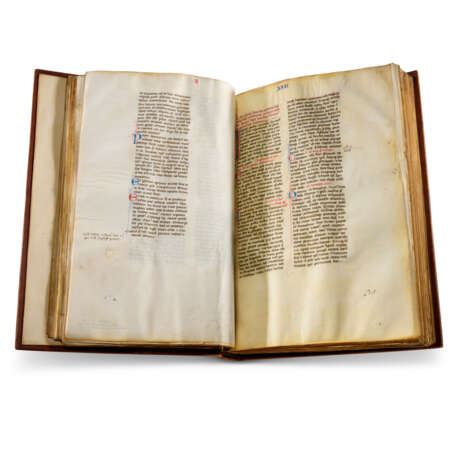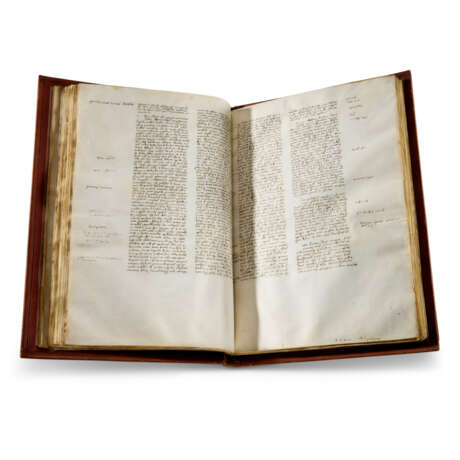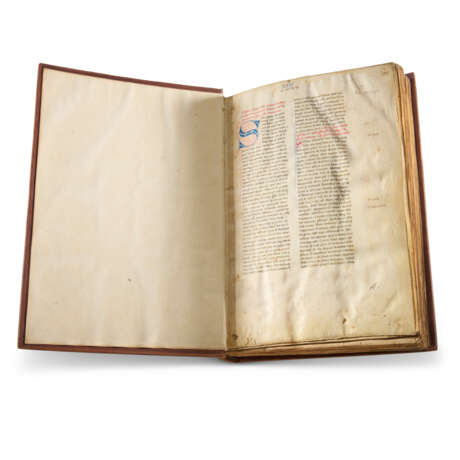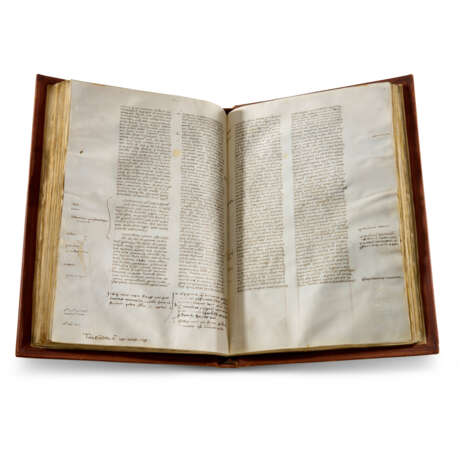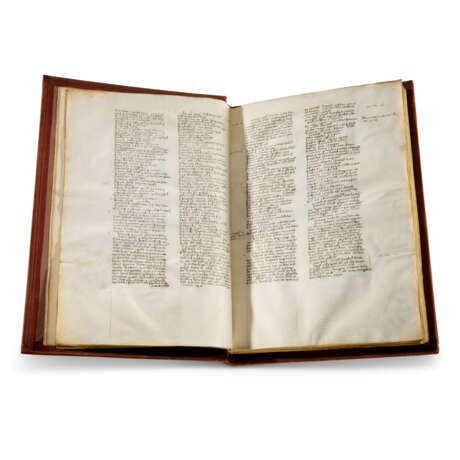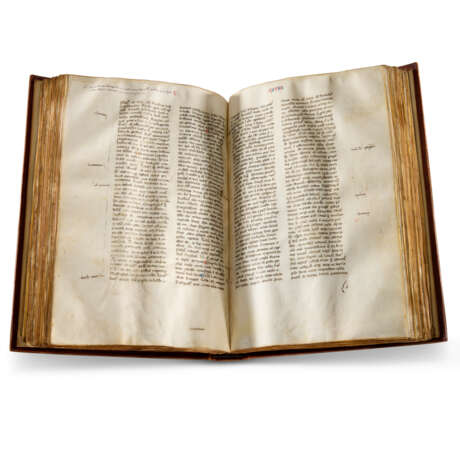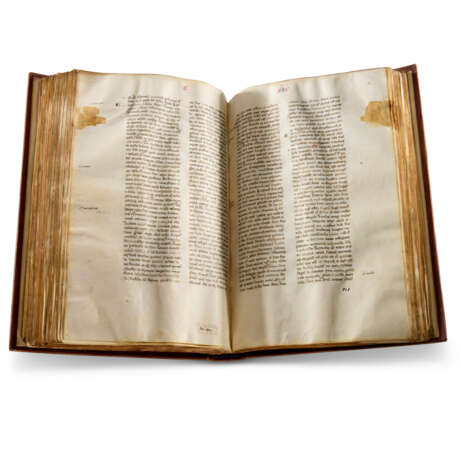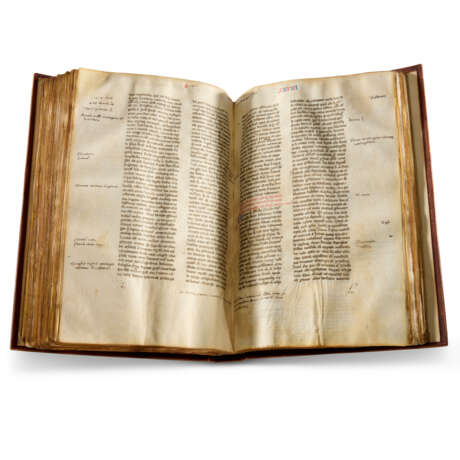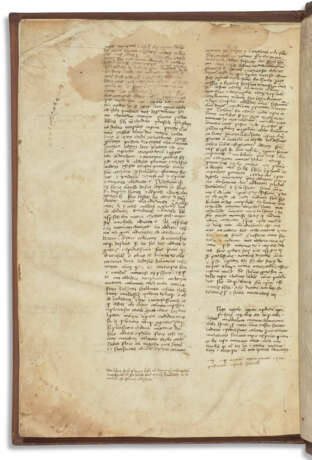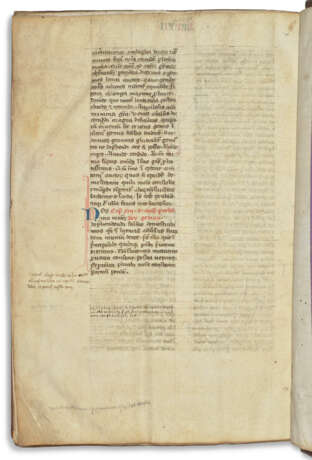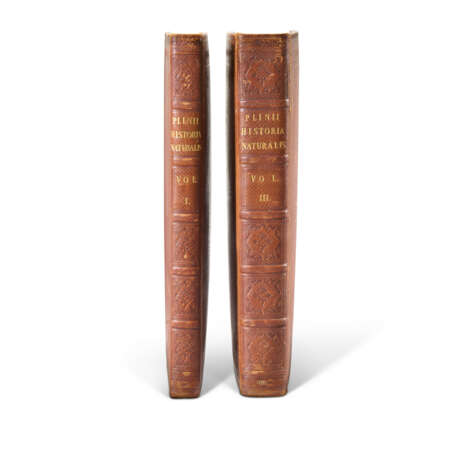ID 1214893
Лот 29 | The Pliny of St James of the Marches
Оценочная стоимость
£ 80 000 – 120 000
Plinius Secundus Maior, Gaius (‘Pliny the Elder’), Naturalis Historia Books 1–13 and 19–37, in Latin, two volumes, decorated manuscripts on vellum [Italy (probably Padua), after 1382 (vol. II) and late 14th or early 15th century (vol. I)]
A fundamental text, almost unknown in private hands, with a distinguished provenance including ownership by a medieval saint who wrote in both volumes and bought them for his monastery.
c. 355 × 250mm. 2 vols.:
Vol. I: ii + I + 105 + I + ii, in gathering 7 ff.47–52 are palimpsests, the under-texts being a legal document written in a single column on one side of the sheet (with a visible notary’s mark), and a literary text in two columns; collation: 1–28, 36; 48, 54, 68; 7–1010; 118, 129 (of 10, x apparently a cancelled blank), 136, with catchwords, the gatherings numbered in the middle of the lower margin on their first rectos, written by several scribes in cursive scripts, ‘some elegant, some scruffy’, with 50–58 lines per page; some of them were apparently copying simultaneously from a disbound exemplar (a manuscript now at Leiden, see below), as there are lines or whole leaves left blank at the end of some of their stints (f.22v, the end of gathering 3; f.42, the end of gathering 6; etc.), gathering 7 has rubrics in red, the others have spaces and notes for the rubricator, blank spaces for coloured initials, extensive marginalia by several scribes including at least one in Greek, f.141v (with natural flaws in the vellum, leaves at the end of the volume lacking their upper outer corner, with some loss of text, stains, and other imperfections, overall somewhat scruffy but legible and with ample margins);
Vol. II: ii + 182 + I½ + ii leaves (the foliation ends at 187, but 33–35, 40, and 55 are absent: apparently cancelled blanks); collation: 1–310, 46 (of 12, iii–iv and ix–xiii cancelled blanks?) 510, 69 (of 10, iv blank, v a cancelled blank?), 710, 88, 9–1810, 197 (of 10, viii–x cancelled blanks?), catchwords throughout, 17th/18th(?)-century alpha-numeric leaf signatures A–T omitting Q, written in gothic script, with rubrics, apparently by a single scribe, in 2 columns of 44–45 lines, 240 × 150mm, the books decorated with a large puzzle initial in red and blue sometimes with reserved designs and spiralling penwork in both colours, small initials alternately red with blue penwork flourishing, or vice versa, running book-numbers in the upper margins in red and blue, extensive marginalia by several scribes (the edge of the leaves darkened, the vellum with a few natural flaws, the blank outer margin of f.37 excised, a few pages or left blank perhaps because the surface was unsuitable for writing, but overall in good condition with very wide margins).
Bound in matching 19th-century (probably 1825/6) English brown diced russia framed by a border of Greek-key ornament, the spines lettered in gilt capitals ‘Plinii Historia naturalis Vol. I. [or III. (sic)]’ (slightly scuffed)
Provenance:
(1) Doubtless written at Padua, as vol. I was copied from an exemplar almost certainly written there, and the exemplar of vol. II was apparently a manuscript also written in the Veneto (see Content). Giacomo della Marca (see below) is known to have been in Padua on several occasions from 1439 to 1460, but Michael Reeve makes a case that he may have acquired the volumes in Dalmatia or Bosnia, where he was from 1432–33 and 1435–38 (Reeve, 2011, p. 212).
(2) St Giacomo della Marca (1394-1476), Franciscan preacher and missionary, student of St Bernardino and colleague of St John Capistrano, founder in 1449 of the monastery at Monteprandone and compiler of two catalogues of its library, datable between 1463 and 1472 (both printed by Lasic, 1971): both volumes inscribed with his acquisition notes, recording that they cost 14 and a half gold ducats, vol. I: ‘Iste liber primus Plinii est sancte M(arie) de Gratiis iuxta opidum Montispran. cum secundo libro ducatis aureis quatuordecim cum dimidio ego frater Jac. eiusdem loci’ (reproduced in Kraus, 1991, p.86); vol. II: ‘Iste liber Plinii est loci sancte M(arie) de Gratiis iuxta opidum Montispran. cum alio volumine videlicet prima pars ducatis quatuordecim cum dimidio auri ego frater Jac. eiusdem loco’; recorded in his library catalogue as ‘Plenius [sic] in duobus voluminibus ducatis 14 cum dimidio’. Michael Reeve (2011, pp.206-7) notes that this is the highest price that Giacomo records for any of his books, and remarks that it would have been enough to buy 3,000 litres of wine.
(3) ?Pope Pius VI (1717-1799): according to Friedrich Blume this was one of nine manuscripts bought around 1825 by Hänel (see below) from the Roman bookseller Mariano de Romanis (1761–1825), and Blume further implies that de Romanis had got them from Pope Pius’s private library (Iter Italicum, III, 1830, pp.210, 216); de Romanis was one of two booksellers to jointly issue a Catalogo della maggior parte dei libri già spettanti alla biblioteca privata di PP. Pio VI., Rome, 1805.
(4) Gustav Hänel (1792-1878), German lawyer, legal historian, and Professor of Leipzig University, who spent 1821-1828 travelling around Europe in search of manuscripts; presumably bought from him on one of their many Continental book-buying trips by:
(5) Payne & Foss, London: offered in A Catalogue of a Very Extensive Collection of Aldine Publications, of Greek and Latin Manuscripts Upon Vellum and Paper […], 1826, no 609, priced £21, with their handwritten draft description bound in (vol. II, after f.154); bought by:
(6) Sir Thomas Phillipps (1792-1872): his MS 4196–4197, with his inscriptions, including ‘Payne’, and printed spine-label, acquired by 1830, when he made a short transcription for Charles Koenig of the Department of Natural History of the British Museum (inserted after f.150); doubtless by descent to his grandson, Thomas Fitzroy Fenwick, who sold the residue of the collection to:
(7) Lionel and Philip Robinson, booksellers; from whom it was perhaps acquired by:
(8) ?H.P. Kraus Inc., New York: their collation on the last flyleaf of vol. I suggests they owned it c.1958.
(9) Harrison D. Horblit (1912–1988), philanthropist and book collector: with his book label; deaccessioned by 1979 back to:
(10) H.P. Kraus: Catalogue 155 [1980], no 14, priced $25,000; reoffered in Catalogue 186 [1991], no 126, priced $80,000; bought by:
(11) The Schøyen Collection, MS 1000.
Content:
Volume I contains Books 1–13.18 (lacking 12.9–67 after f.102); volume II contains Books 19–37. Vol. I was apparently copied directly from Leiden, BPL, MS 6 (dated 1382 and almost certainly written at Padua, and with marginalia copied from Petrarch’s own manuscript, Paris, BnF, MS Lat. 6802). Spaces at the ends of some gatherings, and changes of scribe at junctions between gatherings, suggest that the MS was copied from the disbound gatherings of the Leiden manuscript. Vol. II was apparently copied from Vat. Lat. 1954 (c.1300, Veneto, ‘among the oldest of those written in Italy’, which descends from a Carolingian manuscript, Paris, BnF, MS Lat. 6795). A later addition is 22.48–65, which also descends from the Leiden MS.
The opening rubric of vol. II suggests that it may derive from a complete copy in a single volume, as it starts with the explicit of Book 18: ‘Capitulum. Plinii secundi naturalis hystorie liber .xviij. explicit. Incipit .xix. In quo continentur lini natura & mirabilia. Siderum quoque tempestatumque […]’. The exemplar was apparently incomplete: in the top outer corner of f.55v is a contemporary note ‘debet incipi xxiiij.’ and in the lower margin of the facing page ‘hic deficiunt tria capitula’.
‘No other encyclopaedia has enjoyed so long and so continuous a vogue as the Natural History of the elder Pliny […] it has never ceased to interest the cultured general reader […] astronomers, computists, and students of medicine in the early Middle Ages; geographers and early students of botany and zoology from the twelfth and thirteenth centuries; antiquarians, philologists and art-historians from the later Middle Ages, and other encyclopaedists at all times, have dipped into one or more of its thirty-seven books and rarely come away empty-handed’ (M. Chibnall, ‘Pliny’s Natural History and the Middle Ages’, Empire and Aftermath, ed. T.A. Dorey, London, 1975, pp.57–78, at 57).
Although the text is somewhat incomplete, this is also true of the vast majority of copies in existence. In the long list of copies provided by Reeve, 2007, the only other one in private hands is owned by Lord Leicester at Holkham Hall. According to the Schoenberg database, only one other medieval manuscript of the text (excluding short extracts, paraphrases, etc.) has appeared for sale publicly since the 1830s.
Literature
Crivellucci, A., I Codici della libreria raccolta da S. Giacomo della Marca nel convento di S. Maria delle Grazie presso Monteprandone (Livorno, 1889), cited at pp.14 and 107–08 n. 1.
Lasic, D., ‘Le Tabulae Librorum della libreria di s. Giacomo della Marca’, Picenum Seraphicum, 8 (1971), pp.13–41 at 32 no 142 and 38 no 128.
Lioi, R., ‘Storia e letteratura nella libreria di S. Giacomo della Marca’, ibid., pp, 42–65, at 53.
Reeve, M.D., ‘The Editing of Pliny’s “Natural History”’, Revue d’histoire des textes, 2 (2007) pp. 107–80.
Reeve, M.D., ‘A Manuscript of Pliny Annotated by a Saint from the Marche’, Studi umanistici piceni, 31 (2011), 205–20.
Schenkl, H., Bibliotheca patrum latinorum Britannica, I, pt. 2: Die Phillips’sche [sic] Bibliothek in Cheltenham (Vienna, 1892), p. 68.
| Место происхождения: | Италия, Европа |
|---|---|
| Категория аукционного дома: | Манускрипты Средневековья и Ренессанса, Книги и рукописи |
| Место происхождения: | Италия, Европа |
|---|---|
| Категория аукционного дома: | Манускрипты Средневековья и Ренессанса, Книги и рукописи |
| Адрес торгов |
CHRISTIE'S 8 King Street, St. James's SW1Y 6QT London Великобритания | |
|---|---|---|
| Предосмотр |
| |
| Телефон | +44 (0)20 7839 9060 | |
| Комиссия | see on Website | |
| Условия использования | Условия использования |
